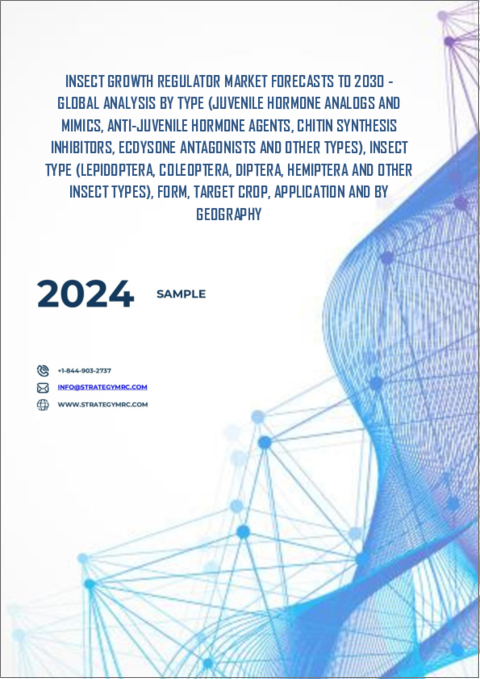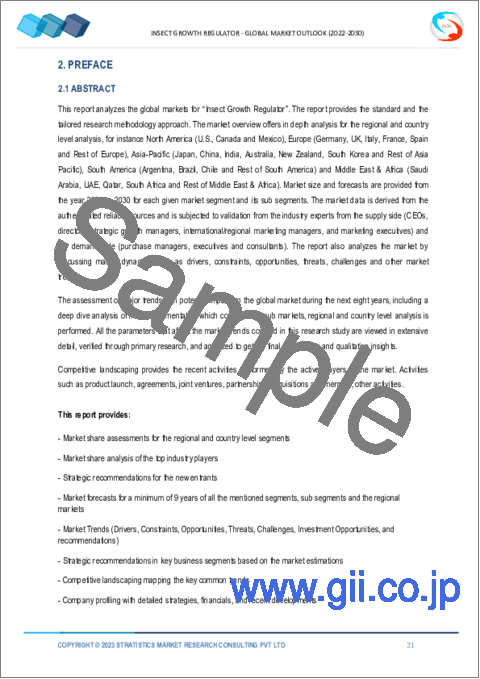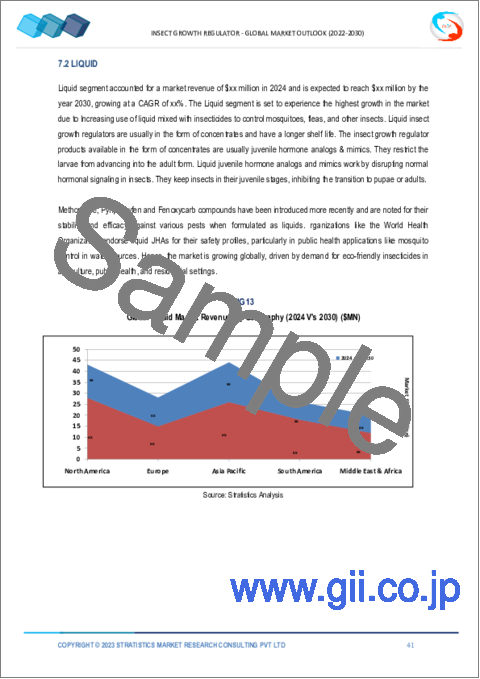|
|
市場調査レポート
商品コード
1462756
昆虫成長制御剤の世界市場:分析 - タイプ別、昆虫タイプ別、形態別、対象作物別、用途別、地域別、予測(~2030年)Insect Growth Regulator Market Forecasts to 2030 - Global Analysis By Type, Insect Type, Form, Target Crop, Application and By Geography |
||||||
カスタマイズ可能
|
|||||||
| 昆虫成長制御剤の世界市場:分析 - タイプ別、昆虫タイプ別、形態別、対象作物別、用途別、地域別、予測(~2030年) |
|
出版日: 2024年04月04日
発行: Stratistics Market Research Consulting
ページ情報: 英文 200+ Pages
納期: 2~3営業日
|
全表示
- 概要
- 図表
- 目次
世界の昆虫成長制御剤の市場規模は、2023年に10億5,400万米ドルに達し、予測期間中にCAGR 8.2%で成長し、2030年には18億2,500万米ドルに達すると予測されています。
昆虫成長制御剤(IGR)は、若年性ホルモンの作用を模倣または阻害することにより、害虫の成長と発達を阻害する殺虫剤の一種です。IGRは脱皮プロセスを阻害し、幼虫が成虫になるのを阻止したり、生存可能な成虫の出現を阻害したりします。IGRは、農業、都市、獣医学的環境において、さまざまな害虫を駆除する総合的害虫管理戦略に広く使用されています。
農業活動の増加
世界人口の拡大と食生活の嗜好の進化に伴い、食糧生産に対する需要が増大し、農業活動の拡大と激化が進んでいます。IGRは、有益な生物への害を最小限に抑え、環境への影響を低減しながら、害虫の個体群に的を絞った駆除を行うため、従来の殺虫剤に代わる実行可能な選択肢となります。さらに、総合的なアプローチで複数の害虫駆除戦略を用いることを重視する総合的害虫管理(IPM)の採用が、IGRの需要をさらに押し上げています。
高コスト
IGRは的を絞った害虫駆除や環境負荷の低減など多くの利点をもたらすが、農家によっては初期投資や継続的な散布費用が高額になる場合があります。IGRのコストには、製品開発、製造、登録、流通などさまざまな要素が含まれます。さらに、生育期を通じて繰り返し散布する必要があるため、全体的な費用がかさみ、市場の拡大が制限されることもあります。
調査と技術の進歩
IGRのセグメントにおける継続的な研究と技術の進歩は、より効果的で的を絞った製品の開発につながっています。調査の進歩により昆虫の生物学と生理学の理解が深まり、IGRが標的とできる特定のライフステージとプロセスに関する洞察が得られるようになった。さらに、技術の進歩によりIGRの製剤化や送達メカニズムが改善され、より使いやすく効率的なものとなっています。したがって、こうした研究と技術の進歩は、市場の需要を加速させる重要な要因となっています。
規制上の課題
新しいIGR製品の登録・承認プロセスは複雑で時間がかかるため、メーカーは当局が定める厳しい規制要件を満たす必要があります。メーカーは包括的な研究を実施し、IGR製品の安全性、有効性、環境への影響に関する科学的証拠を提供する必要があります。しかし、このデータ収集プロセスには費用と時間がかかり、特に経営資源の限られた中小企業にとっては大きな負担となります。このような規制要件を満たすことは、製造業者、特に中小企業にとって課題となり、その結果、新しいIGR製品の市場投入が遅れることになります。
COVID-19の影響
COVID-19の大流行は昆虫成長制御剤(IGR)市場に大きな影響を与えました。当初、サプライチェーンの混乱と物流の課題がIGR製品の入手と流通を妨げました。さらに、パンデミックによる景気悪化は農家の財政制約を招き、IGRよりも必要不可欠な投入資材を優先したり、農業支出全体を削減したりする農家も出てきました。
キチン合成阻害剤セグメントは予測期間中最大となる見込み
キチン合成阻害剤セグメントは、その選択的な作用様式と、従来の殺虫剤に比べて非標的生物や環境への影響が少ないことから、最大のシェアを占めると推定されます。CSIは、カイガラムシ、イモムシ、様々な農業害虫を含む広範な害虫駆除に効果的な代替手段を提供し、耐性発生のリスクも最小限に抑えることができます。さらに、CSIは総合的害虫管理(IPM)アプローチとの適合性を示し、生物的防除剤、文化的実践、その他の害虫管理戦術とともに総合的害虫駆除戦略に組み込むことができます。
予測期間中、農業セグメントのCAGRが最も高くなると予想される
農業セグメントは、予測期間中に有利な成長が見込まれます。これらの化学薬品は、昆虫のホルモン系を標的とすることで昆虫の発育を阻害し、脱皮や変態を阻害します。従来の殺虫剤とは異なり、選択性が高く、有益な生物や環境へのリスクは最小限に抑えられます。さらに、蚊やハエ、農作物の害虫といった害虫を駆除するための総合的な害虫管理戦略で一般的に使用されています。昆虫の成長と繁殖を妨げることで、IGRは生態系への影響を最小限に抑えながら、農業における効果的で持続可能な害虫駆除ソリューションを提供します。
最大のシェアを占める地域
アジア太平洋は、農業慣行、気候条件、害虫の圧力が多様であることを特徴とし、予測期間中に最大の市場シェアを占めました。環境の持続可能性に関する意識の高まりが、より安全で環境に優しい害虫管理の代替策へのシフトを促し、IGRの取り込みを後押ししています。さらに、化学農薬の使用を最小限に抑えながら農業生産性の向上を目指す政府の取り組みが、市場の成長をさらに刺激しています。
CAGRが最も高い地域:
北米は予測期間中、収益性の高い成長が見込まれます。この地域では、トウモロコシ、大豆、綿花、果物などの主要作物を含む大規模な農業経営が行われているため、作物の損失を軽減するための効果的な害虫管理ソリューションに対するニーズが高まっています。さらに、従来の化学農薬が環境や健康に与える影響への懸念と相まって、害虫の蔓延が増加していることから、IGRのような安全で持続可能な代替品へのシフトが加速しています。
目次
第1章 エグゼクティブサマリー
第2章 序文
- 概要
- ステークホルダー
- 調査範囲
- 調査手法
- データマイニング
- データ分析
- データ検証
- 調査アプローチ
- 調査情報源
- 1次調査情報源
- 2次調査情報源
- 前提条件
第3章 市場動向分析
- 促進要因
- 抑制要因
- 機会
- 脅威
- 用途分析
- 新興市場
- COVID-19症の影響
第4章 ポーターのファイブフォース分析
- 供給企業の交渉力
- 買い手の交渉力
- 代替品の脅威
- 新規参入業者の脅威
- 競争企業間の敵対関係
第5章 世界の昆虫成長制御剤市場:タイプ別
- 若年性ホルモン類似体および模倣体
- 抗少年ホルモン剤
- キチン合成阻害剤
- エクジソン拮抗薬
- その他のタイプ
第6章 世界の昆虫成長制御剤市場:昆虫タイプ別
- チョウ目
- 甲虫目
- 双翅目
- 半翅目
- その他の昆虫タイプ
第7章 世界の昆虫成長制御剤市場:形態別
- 液体
- エアゾール
- ベイト剤
第8章 世界の昆虫成長制御剤市場:対象作物別
- 穀類・穀物
- 油糧種子・豆類
- 果物・野菜
- その他の対象作物
第9章 世界の昆虫成長制御剤市場:用途別
- 家畜
- 住宅
- 農業
- 園芸作物
- 畑作物
- 芝生・観賞植物
- 商業
- その他の用途
第10章 世界の昆虫成長制御剤市場:地域別
- 北米
- 米国
- カナダ
- メキシコ
- 欧州
- ドイツ
- 英国
- イタリア
- フランス
- スペイン
- その他の欧州
- アジア太平洋
- 日本
- 中国
- インド
- オーストラリア
- ニュージーランド
- 韓国
- その他のアジア太平洋
- 南米
- アルゼンチン
- ブラジル
- チリ
- その他の南米
- 中東・アフリカ
- サウジアラビア
- アラブ首長国連邦
- カタール
- 南アフリカ
- その他の中東・アフリカ
第11章 主な発展
- 契約、パートナーシップ、コラボレーション、合弁事業
- 買収と合併
- 新製品発売
- 事業拡大
- その他の主要戦略
第12章 企業プロファイリング
- Sumitomo Chemical Co., Ltd.
- DowDupont Inc.
- Adama Agricultural Solutions Ltd.
- Nufarm Limited
- BASF SE
- Bayer AG
- Central Life Sciences
- Syngenta AG
- OHP Inc.
- HELM Agro US, Inc.
- Russell IPM
- Nufarm
- Valent U.S.A. LLC
- McLaughlin Gormley King Co., Inc.
- Control Solutions, Inc.
- Central Garden & Pet Company
List of Tables
- Table 1 Global Insect Growth Regulator Market Outlook, By Region (2021-2030) ($MN)
- Table 2 Global Insect Growth Regulator Market Outlook, By Type (2021-2030) ($MN)
- Table 3 Global Insect Growth Regulator Market Outlook, By Juvenile Hormone Analogs and Mimics (2021-2030) ($MN)
- Table 4 Global Insect Growth Regulator Market Outlook, By Anti-Juvenile Hormone Agents (2021-2030) ($MN)
- Table 5 Global Insect Growth Regulator Market Outlook, By Chitin Synthesis Inhibitors (2021-2030) ($MN)
- Table 6 Global Insect Growth Regulator Market Outlook, By Ecdysone Antagonists (2021-2030) ($MN)
- Table 7 Global Insect Growth Regulator Market Outlook, By Other Types (2021-2030) ($MN)
- Table 8 Global Insect Growth Regulator Market Outlook, By Insect Type (2021-2030) ($MN)
- Table 9 Global Insect Growth Regulator Market Outlook, By Lepidoptera (2021-2030) ($MN)
- Table 10 Global Insect Growth Regulator Market Outlook, By Coleoptera (2021-2030) ($MN)
- Table 11 Global Insect Growth Regulator Market Outlook, By Diptera (2021-2030) ($MN)
- Table 12 Global Insect Growth Regulator Market Outlook, By Hemiptera (2021-2030) ($MN)
- Table 13 Global Insect Growth Regulator Market Outlook, By Other Insect Types (2021-2030) ($MN)
- Table 14 Global Insect Growth Regulator Market Outlook, By Form (2021-2030) ($MN)
- Table 15 Global Insect Growth Regulator Market Outlook, By Liquid (2021-2030) ($MN)
- Table 16 Global Insect Growth Regulator Market Outlook, By Aerosol (2021-2030) ($MN)
- Table 17 Global Insect Growth Regulator Market Outlook, By Bait (2021-2030) ($MN)
- Table 18 Global Insect Growth Regulator Market Outlook, By Target Crop (2021-2030) ($MN)
- Table 19 Global Insect Growth Regulator Market Outlook, By Cereals & Grains (2021-2030) ($MN)
- Table 20 Global Insect Growth Regulator Market Outlook, By Oilseeds & Pulses (2021-2030) ($MN)
- Table 21 Global Insect Growth Regulator Market Outlook, By Fruits & Vegetables (2021-2030) ($MN)
- Table 22 Global Insect Growth Regulator Market Outlook, By Other Target Crops (2021-2030) ($MN)
- Table 23 Global Insect Growth Regulator Market Outlook, By Application (2021-2030) ($MN)
- Table 24 Global Insect Growth Regulator Market Outlook, By Livestock (2021-2030) ($MN)
- Table 25 Global Insect Growth Regulator Market Outlook, By Residential (2021-2030) ($MN)
- Table 26 Global Insect Growth Regulator Market Outlook, By Agriculture (2021-2030) ($MN)
- Table 27 Global Insect Growth Regulator Market Outlook, By Horticultural Crops (2021-2030) ($MN)
- Table 28 Global Insect Growth Regulator Market Outlook, By Field Crops (2021-2030) ($MN)
- Table 29 Global Insect Growth Regulator Market Outlook, By Turf & Ornamentals (2021-2030) ($MN)
- Table 30 Global Insect Growth Regulator Market Outlook, By Commercial (2021-2030) ($MN)
- Table 31 Global Insect Growth Regulator Market Outlook, By Other Applications (2021-2030) ($MN)
Note: Tables for North America, Europe, APAC, South America, and Middle East & Africa Regions are also represented in the same manner as above.
According to Stratistics MRC, the Global Insect Growth Regulator Market is accounted for $1054 million in 2023 and is expected to reach $1825 million by 2030 growing at a CAGR of 8.2% during the forecast period. Insect growth regulators (IGRs) are a class of insecticides that disrupt the growth and development of insect pests by mimicking or inhibiting the action of juvenile hormones. IGRs interfere with the molting process, preventing larvae from reaching maturity or inhibiting the emergence of viable adults. IGRs are widely used in integrated pest management strategies to control a variety of insect pests in agricultural, urban, and veterinary settings.
Market Dynamics:
Driver:
Rise in agricultural activities
As global populations expand and dietary preferences evolve, there is an increasing demand for food production, driving agricultural activities to expand and intensify. IGRs offer a viable alternative to conventional pesticides, as they provide targeted control over pest populations while minimizing harm to beneficial organisms and reducing environmental impact. Moreover, the adoption of integrated pest management (IPM) practices, which emphasize the use of multiple pest control strategies in a holistic approach, further drives the demand for IGRs.
Restraint:
High cost
While IGRs offer numerous benefits, including targeted pest control and reduced environmental impact, their initial investment and ongoing application expenses can be prohibitive for some farmers. The cost of IGRs encompasses various factors, including product development, manufacturing, registration, and distribution. Additionally, the need for repeated applications throughout the growing season can contribute to the overall expense, which limits market expansion.
Opportunity:
Advancements in research and technology
Ongoing research and technological advancements in the field of IGRs have led to the development of more effective and targeted products. Advancements in research have led to a better understanding of insect biology and physiology, providing insights into the specific life stages and processes that can be targeted by IGRs. Furthermore, technological advancements have improved the formulation and delivery mechanisms of IGRs, making them more user-friendly and efficient. Therefore, these advancements in research and technology are significant factors in accelerating market demand.
Threat:
Regulatory challenges
The registration and approval process for new IGR products can be complex and time-consuming, requiring manufacturers to meet stringent regulatory requirements set by authorities. Manufacturers need to conduct comprehensive studies and provide scientific evidence on the safety, efficacy, and environmental impact of their IGR products. However, this data collection process can be expensive and time-consuming, particularly for smaller companies with limited resources. Meeting these regulatory requirements can pose challenges for manufacturers, particularly smaller companies, and result in delays in bringing new IGR products to the market.
Covid-19 Impact
The COVID-19 pandemic had a significant impact on the insect growth regulator (IGR) market. Initially, disruptions in supply chains and logistical challenges hampered the availability and distribution of IGR products. Furthermore, the economic downturn caused by the pandemic led to financial constraints among farmers, prompting some to prioritize essential inputs over IGRs or reduce their overall agricultural expenditures.
The chitin synthesis inhibitors segment is expected to be the largest during the forecast period
The chitin synthesis inhibitors segment is estimated to hold the largest share, due to their selective mode of action and reduced impact on non-target organisms and the environment compared to traditional insecticides. They offer an effective alternative for controlling a wide range of insect pests, including beetles, caterpillars, and various agricultural pests, while minimizing the risk of resistance development. Furthermore, CSIs demonstrate compatibility with integrated pest management (IPM) approaches, allowing for their integration into holistic pest control strategies alongside biological control agents, cultural practices, and other pest management tactics.
The agriculture segment is expected to have the highest CAGR during the forecast period
The agriculture segment is anticipated to have lucrative growth during the forecast period. These chemicals disrupt the development of insects by targeting their hormonal systems, inhibiting molting or metamorphosis. Unlike traditional insecticides, they are more selective, posing minimal risk to beneficial organisms and the environment. Moreover, they're commonly used in integrated pest management strategies to control pests like mosquitoes, flies, and agricultural crop pests. By interfering with insect growth and reproduction, IGRs offer effective, sustainable pest control solutions in agriculture while minimizing ecological impacts.
Region with largest share:
Asia Pacific commanded the largest market share during the extrapolated period characterized by a diverse landscape of agricultural practices, climatic conditions, and pest pressures. Increasing awareness regarding environmental sustainability propels the shift towards safer and eco-friendly pest management alternatives, favouring IGRs' uptake. Moreover, government initiatives aimed at enhancing agricultural productivity while minimizing chemical pesticide usage further stimulate market growth.
Region with highest CAGR:
North America is expected to witness profitable growth over the projection period. The region's large-scale agricultural operations, including major crops like corn, soybeans, cotton, and fruits, create a substantial need for effective pest management solutions to mitigate crop losses. Furthermore, the increasing prevalence of insect pests, coupled with concerns over the environmental and health impacts of traditional chemical pesticides, has fuelled the shift towards safer and more sustainable alternatives like IGRs.
Key players in the market
Some of the key players in the Insect Growth Regulator Market include Sumitomo Chemical Co., Ltd., DowDupont Inc., Adama Agricultural Solutions Ltd., Nufarm Limited, BASF SE, Bayer AG, Central Life Sciences, Syngenta AG, OHP Inc., HELM Agro US, Inc., Russell IPM, Nufarm, Valent U.S.A. LLC, McLaughlin Gormley King Co., Inc., Control Solutions, Inc. and Central Garden & Pet Company.
Key Developments:
In February 2024, Syngenta AG and Lavie Bio Ltd., a subsidiary of Evogene Ltd. and a leading ag-biologicals company, announced an agreement for the discovery and development of new biological insecticidal solutions.
In July 2023, Sumitomo Chemical Co., Ltd and Ginkgo Bioworks announced a new program to develop functional chemicals with synthetic biology and expand upon the companies' existing bio manufacturing partnership.
In September 2022, BASF announces innovation partnership with RiKarbon on emollients derived from bio-waste, partnership builds on successful R&D activities of RiKarbon Inc. for new green emollients from bio-waste for personal care formulations
Types Covered:
- Juvenile Hormone Analogs and Mimics
- Anti-Juvenile Hormone Agents
- Chitin Synthesis Inhibitors
- Ecdysone Antagonists
- Other Types
Insect Types Covered:
- Lepidoptera
- Coleoptera
- Diptera
- Hemiptera
- Other Insect Types
Forms Covered:
- Liquid
- Aerosol
- Bait
Target Crops Covered:
- Cereals & Grains
- Oilseeds & Pulses
- Fruits & Vegetables
- Other Target Crops
Applications Covered:
- Livestock
- Residential
- Agriculture
- Commercial
- Other Applications
Regions Covered:
- North America
- US
- Canada
- Mexico
- Europe
- Germany
- UK
- Italy
- France
- Spain
- Rest of Europe
- Asia Pacific
- Japan
- China
- India
- Australia
- New Zealand
- South Korea
- Rest of Asia Pacific
- South America
- Argentina
- Brazil
- Chile
- Rest of South America
- Middle East & Africa
- Saudi Arabia
- UAE
- Qatar
- South Africa
- Rest of Middle East & Africa
What our report offers:
- Market share assessments for the regional and country-level segments
- Strategic recommendations for the new entrants
- Covers Market data for the years 2021, 2022, 2023, 2026, and 2030
- Market Trends (Drivers, Constraints, Opportunities, Threats, Challenges, Investment Opportunities, and recommendations)
- Strategic recommendations in key business segments based on the market estimations
- Competitive landscaping mapping the key common trends
- Company profiling with detailed strategies, financials, and recent developments
- Supply chain trends mapping the latest technological advancements
Free Customization Offerings:
All the customers of this report will be entitled to receive one of the following free customization options:
- Company Profiling
- Comprehensive profiling of additional market players (up to 3)
- SWOT Analysis of key players (up to 3)
- Regional Segmentation
- Market estimations, Forecasts and CAGR of any prominent country as per the client's interest (Note: Depends on feasibility check)
- Competitive Benchmarking
- Benchmarking of key players based on product portfolio, geographical presence, and strategic alliances
Table of Contents
1 Executive Summary
2 Preface
- 2.1 Abstract
- 2.2 Stake Holders
- 2.3 Research Scope
- 2.4 Research Methodology
- 2.4.1 Data Mining
- 2.4.2 Data Analysis
- 2.4.3 Data Validation
- 2.4.4 Research Approach
- 2.5 Research Sources
- 2.5.1 Primary Research Sources
- 2.5.2 Secondary Research Sources
- 2.5.3 Assumptions
3 Market Trend Analysis
- 3.1 Introduction
- 3.2 Drivers
- 3.3 Restraints
- 3.4 Opportunities
- 3.5 Threats
- 3.6 Application Analysis
- 3.7 Emerging Markets
- 3.8 Impact of Covid-19
4 Porters Five Force Analysis
- 4.1 Bargaining power of suppliers
- 4.2 Bargaining power of buyers
- 4.3 Threat of substitutes
- 4.4 Threat of new entrants
- 4.5 Competitive rivalry
5 Global Insect Growth Regulator Market, By Type
- 5.1 Introduction
- 5.2 Juvenile Hormone Analogs and Mimics
- 5.3 Anti-Juvenile Hormone Agents
- 5.4 Chitin Synthesis Inhibitors
- 5.5 Ecdysone Antagonists
- 5.6 Other Types
6 Global Insect Growth Regulator Market, By Insect Type
- 6.1 Introduction
- 6.2 Lepidoptera
- 6.3 Coleoptera
- 6.4 Diptera
- 6.5 Hemiptera
- 6.6 Other Insect Types
7 Global Insect Growth Regulator Market, By Form
- 7.1 Introduction
- 7.2 Liquid
- 7.3 Aerosol
- 7.4 Bait
8 Global Insect Growth Regulator Market, By Target Crop
- 8.1 Introduction
- 8.2 Cereals & Grains
- 8.3 Oilseeds & Pulses
- 8.4 Fruits & Vegetables
- 8.5 Other Target Crops
9 Global Insect Growth Regulator Market, By Application
- 9.1 Introduction
- 9.2 Livestock
- 9.3 Residential
- 9.4 Agriculture
- 9.4.1 Horticultural Crops
- 9.4.2 Field Crops
- 9.4.3 Turf & Ornamentals
- 9.5 Commercial
- 9.6 Other Applications
10 Global Insect Growth Regulator Market, By Geography
- 10.1 Introduction
- 10.2 North America
- 10.2.1 US
- 10.2.2 Canada
- 10.2.3 Mexico
- 10.3 Europe
- 10.3.1 Germany
- 10.3.2 UK
- 10.3.3 Italy
- 10.3.4 France
- 10.3.5 Spain
- 10.3.6 Rest of Europe
- 10.4 Asia Pacific
- 10.4.1 Japan
- 10.4.2 China
- 10.4.3 India
- 10.4.4 Australia
- 10.4.5 New Zealand
- 10.4.6 South Korea
- 10.4.7 Rest of Asia Pacific
- 10.5 South America
- 10.5.1 Argentina
- 10.5.2 Brazil
- 10.5.3 Chile
- 10.5.4 Rest of South America
- 10.6 Middle East & Africa
- 10.6.1 Saudi Arabia
- 10.6.2 UAE
- 10.6.3 Qatar
- 10.6.4 South Africa
- 10.6.5 Rest of Middle East & Africa
11 Key Developments
- 11.1 Agreements, Partnerships, Collaborations and Joint Ventures
- 11.2 Acquisitions & Mergers
- 11.3 New Product Launch
- 11.4 Expansions
- 11.5 Other Key Strategies
12 Company Profiling
- 12.1 Sumitomo Chemical Co., Ltd.
- 12.2 DowDupont Inc.
- 12.3 Adama Agricultural Solutions Ltd.
- 12.4 Nufarm Limited
- 12.5 BASF SE
- 12.6 Bayer AG
- 12.7 Central Life Sciences
- 12.8 Syngenta AG
- 12.9 OHP Inc.
- 12.10 HELM Agro US, Inc.
- 12.11 Russell IPM
- 12.12 Nufarm
- 12.13 Valent U.S.A. LLC
- 12.14 McLaughlin Gormley King Co., Inc.
- 12.15 Control Solutions, Inc.
- 12.16 Central Garden & Pet Company





